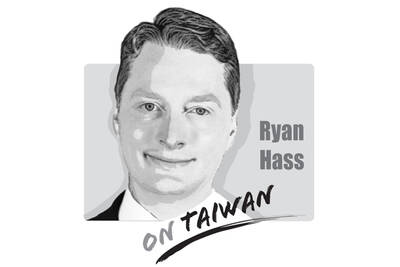More than 100 people have died in swine flu outbreaks in the US and Mexico, causing another global panic like that created by the outbreak of SARS. But Taiwan’s government has been tardy in laying out a disease prevention strategy, while the immediate response has not been comprehensive.
If swine flu — like SARS — is transmitted through close human contact, it is easy to see that more human interaction will lead to a higher infection risk. Therefore in urban areas, especially larger cities, infection rates will be higher. When creating a prevention strategy, the big challenge is to increase the efficiency of how prevention resources are distributed.
We first need to discuss the pattern of disease spread. If we can grasp how this takes place, prevention work can be carried out in potential infection zones. Since it is difficult to predict individual behavior, let alone wider social interaction, it is also difficult to understand how a disease spreads between individuals and groups.
If, however, we widen our perspective to the level of the city, we can assume or perhaps show through experimental data that the number of infections is proportional to a city’s population. If this assumption holds, we might be able to identify principles for distribution of prevention resources based on my recent study on rural-urban scale distribution.
Complex systems in natural and human environments share similarities, as seen in the collapse of the Soviet Union, stock markets, earthquake frequency and urban space distribution. Complexity science aims to explore the characteristics of complex systems. In the context of larger spaces, swine flu must spread via carriers to each city and county through the transportation network.
My study of population distribution scales in Taiwan’s urban and rural areas using computer simulations shows that the distribution of urban systems displays characteristics of scale-free networks. In other words, once a logarithm has been established for population size and number of cities, the distribution displays a clear relationship.
The number of big cities is lower than that of small towns, and there should be a statistical relationship between population size and node number in individual interaction networks. This may be able to serve as an index to the number of nodes for a network. So if we want to prevent swine flu from being transmitted through urban-rural networks, we need to find the most crucial points on the networks, or hubs.
According to one academic analysis of scale-free networks, we should concentrate prevention resources in such hubs to eliminate their distributive function and thus control the spread of the disease.
In other words, we should make every effort to control the disease in larger urban areas such as Taipei and Kaohsiung, and then assess the situation in smaller towns according to size, so that transmission networks for a disease can be disrupted.
Prevention work within a city can also follow this rule. By identifying the hubs of interpersonal interaction networks — such as public places with frequent human activity — we might be better able to block channels for disease transmission and protect the city as a whole.
Technical issues of prevention depend on the collective effort of professional medical workers. It is better for the government to launch cross-disciplinary teams with medical workers and professionals from all fields so that all necessary precautions can be taken before the situation arises. The battle can then be won together.
Lai Shih-kung is a professor in the Department of Real Estate and Built Environment at National Taipei University.
TRANSLATED BY EDDY CHANG
A few weeks ago in Kaohsiung, tech mogul turned political pundit Robert Tsao (曹興誠) joined Western Washington University professor Chen Shih-fen (陳時奮) for a public forum in support of Taiwan’s recall campaign. Kaohsiung, already the most Taiwanese independence-minded city in Taiwan, was not in need of a recall. So Chen took a different approach: He made the case that unification with China would be too expensive to work. The argument was unusual. Most of the time, we hear that Taiwan should remain free out of respect for democracy and self-determination, but cost? That is not part of the usual script, and
Behind the gloating, the Chinese Nationalist Party (KMT) must be letting out a big sigh of relief. Its powerful party machine saved the day, but it took that much effort just to survive a challenge mounted by a humble group of active citizens, and in areas where the KMT is historically strong. On the other hand, the Democratic Progressive Party (DPP) must now realize how toxic a brand it has become to many voters. The campaigners’ amateurism is what made them feel valid and authentic, but when the DPP belatedly inserted itself into the campaign, it did more harm than good. The
For nearly eight decades, Taiwan has provided a home for, and shielded and nurtured, the Chinese Nationalist Party (KMT). After losing the Chinese Civil War in 1949, the KMT fled to Taiwan, bringing with it hundreds of thousands of soldiers, along with people who would go on to become public servants and educators. The party settled and prospered in Taiwan, and it developed and governed the nation. Taiwan gave the party a second chance. It was Taiwanese who rebuilt order from the ruins of war, through their own sweat and tears. It was Taiwanese who joined forces with democratic activists

China has not been a top-tier issue for much of the second Trump administration. Instead, Trump has focused considerable energy on Ukraine, Israel, Iran, and defending America’s borders. At home, Trump has been busy passing an overhaul to America’s tax system, deporting unlawful immigrants, and targeting his political enemies. More recently, he has been consumed by the fallout of a political scandal involving his past relationship with a disgraced sex offender. When the administration has focused on China, there has not been a consistent throughline in its approach or its public statements. This lack of overarching narrative likely reflects a combination